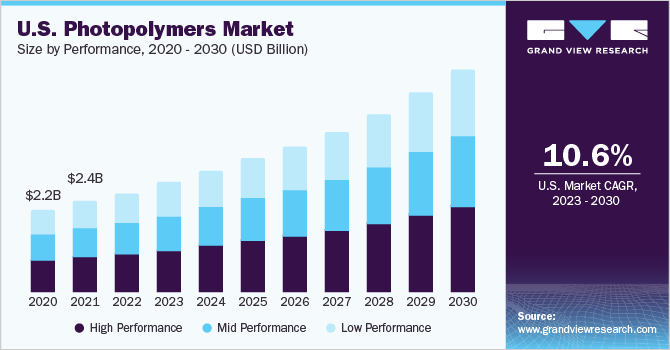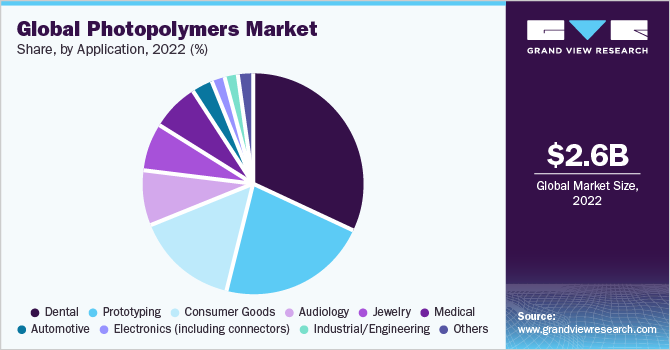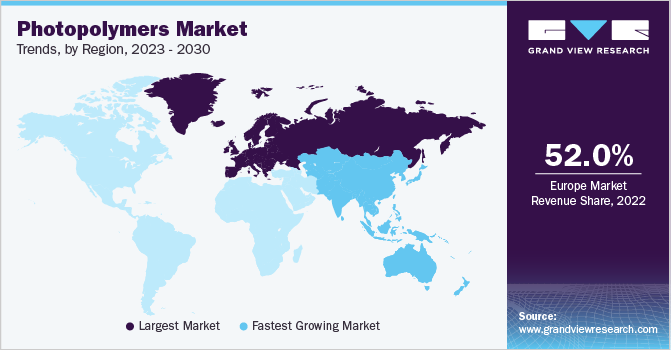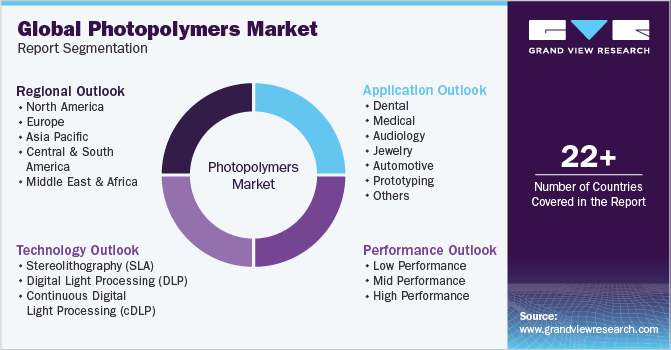
Photopolymers Market Size, Share & Trends Analysis Report By Performance (Low, Mid, High), By Technology (SLA, DLP, cDLP), By Application (Dental, Medical, Audiology, Jewellery, Automotive, Prototyping), By Region, And Segment Forecasts, 2023 - 2030
- Report ID: GVR-4-68040-123-3
- Number of Pages: 120
- Format: Electronic (PDF)
- Historical Range: 2018 - 2021
- Industry:Bulk Chemicals
Report Overview
The globalphotopolymers market sizewas valued atUSD 2.60 billion in 2022and is expected to grow a compound annual growth rate (CAGR) of 10.6% from 2023 to 2030. The growth of the market can be attributed to the increasing utilization of high-speed printing, durable complex 3D printed objects, along design precision are anticipated to propel the demand for the market. Rising demand for prototyping across the automotive industry and designs for understanding complex surgical procedures have increased the demand for photopolymer for3D printing. Furthermore, increasing demand for artificial jewelry and prosthetics across the global population are further propelling the market growth.

The U.S. dominated the market in North America in 2022 owing to the rising demand for photopolymers from the automotive industry in the country. Original equipment manufacturers (OEMs) in the U.S. are focusing on upgrading traditional prototyping and component-developing methods.
The requirement for manufacturing automotive components such as high-performance components at a large scale, ensuring an abundant supply of spare parts using 3D printing, and easing general component manufacturing is anticipated to propel the demand for photopolymers used for 3D printing of components across the U.S. during the forecast period.
Performance Insights
High-performance 3D printing dominated the performance segments across the market with are market share of more than 38.0%. High-performance 3D printing refers to technologies that endure exceptional capabilities in terms of high speed, precision, material options, and the highest print quality. These high-performance 3D printing technologies include selective laser melting (SLM), electron beam melting (EBM), continuous liquid interface production (CLIP), and multi-material 3D printing.
Mid-performance 3D printing refers to technologies, which can balance affordability and performance. These technologies include Digital Light Processing (DLP), Multi Jet Fusion (MJF), Poly Jet, and Bound Metal Deposition (BMD) by Desktop Metal, which can provide decent printing speed, accuracy, and material options without reaching the highest levels of performance in advanced or industrial-grade systems.
Low-performance 3D printing refers to less advanced versions of 3D printing technologies that have limited speed and accuracy and can be used for a few material types. The methods used in low-performance 3D printing are Fused Deposition Modeling (FDM), Selective Laser Sintering (SLS), and binder jetting. However, the rise in demand for durable 3D printed products that can be manufactured easily has propelled manufacturers of 3D printers and providers of associated technologies to introduce highly advanced 3D printing equipment for developing these products.
Technology Insights
The Stereolithography (SLA) 3D printing technology dominated the technology segmentation across the market with a market share of more than 56.0%. SLA is the most commonly used 3D printing technology across the world. It utilizes laser light sources to carry out 3D printing of objects. The global demand for SLA-based 3D printing has rapidly increased in recent years owing to its ability to print 25-300-micron components at a high XY resolution utilizingplastic resinsand photopolymers.
In contrast to traditionally used SLA-based 3D printing technology, digital light processing (DLP)- based 3D printing utilizes arc lamps as light sources instead of laser beams for the formation of 3D printed objects. DLP-based 3D printing is utilized for developing extremely intricate resin designs for jewelry, toys, figurines, dental molds, and more.
Continuous digital light processing (cDLP) is a vat-polymerization-based 3D printing technology, which carries out high-volume and scalable component production. It is a more accurate technology than traditional DLP-based 3D printing technology since the former immediately pushes out the product, hence utilizing an oxygen (O2) membrane to avoid the formation of a vacuum during the printing process.
Application Insights
The dental segmentation dominated the application segmentation across the market with a market share of more than 32.0%. The photopolymers in 3D printing across the dental industry have witnessed a rise in demand in the past few years on account of their benefits, such as high-quality molds, perfect & precise designs, smoother surfaces, and higher durability, in comparison to the traditional process of manufacturing molds using thermoforming.
The adoption of the prototyping process, especially the rapid prototyping process across various industries worldwide, has been driving the demand for photopolymers used for 3D printing prototypes of various products. Additionally, technologies such as SLA, DLP, and cDLP are being adopted globally to produce prototypes in bulk in a short time. This is anticipated to drive the growth of the prototyping application segment of the market in the coming years.

消费品用于运动和休闲目的,along with frame glasses, have witnessed a rise in their popularity across the world. This is due to these goods being handy, despite their complex designs. The surging global demand for consumer goods is fueling the adoption of photopolymer-based 3D printing for their bulk production. Moreover, the rise in demand for aesthetic products for consumer utilization worldwide is also leading to the large-scale use of photopolymer-based 3D printing for developing consumer goods, thereby leading to the growth of the market.
Audiology incorporatinghearing aidsand high-sound earplugs has been utilizing 3D printing for faster, high-quality, and precise design productions. Hearing aids such as in-the-ear, behind-the-ear, and over-the-counter are designed precisely as per the requirement using DLP and SLA 3D printing. Rising demand for hearing devices is likely to drive the growth of photopolymers across the 3D printing industry during the forecast period.
Audiology incorporating hearing aids and high-sound earplugs has been utilizing 3D printing for faster, high-quality, and precise design productions. Hearing aids such as in-the-ear, behind-the-ear, and over-the-counter are designed precisely as per the requirement using DLP and SLA 3D printing. Rising demand for hearing devices is likely to drive the growth of photopolymers across the 3D printing industry during the forecast period.
Regional Insights
Europe dominated the market and accounted for a revenue share of over 52.0% in 2022. Europe is home to some prominent automobile manufacturers of the world. As such, the region dominates the global automotive industry and this trend is anticipated to continue over the forecast period as well.
The rise in demand for lightweight electric and hybrid vehicles and the presence of major automotive manufacturers, including Automobili Lamborghini S.p.A., AUDI AG, Mercedes-Benz AG, Volvo Car Corporation, Volkswagen, FCA Italy S.p.A., BMW AG, Jaguar Land Rover Limited, Ferrari S.p.A., Porsche Austria GmbH & Co., and Aston Martin, in the region are expected to drive the demand for photopolymers for manufacturing automobile components using 3D printing technology.

The growth of the market in North America is majorly driven by the surging demand for photopolymers from the medical and prosthetics industries in countries such as the U.S., Canada, and Mexico. The rise in environmental concerns and an increase in global attempts to reduce pollution are propelling the consumption of photopolymers in the packaging industry across the region.
The manufacturing industry in the Asia Pacific region is diversified and fast-growing. Across emerging economies such as China and India, industries including automotive, electrical & electronics, consumer goods, medical, and others have expanded significantly in the past decade. The benefits of VAT polymerization in 3D printing, in alignment with the manufacturing industry and increased demand for photopolymers, include personalization, prototyping, and small-batch production.
Key Companies & Market Share Insights
Major players in the photopolymers market have integrated their raw material production and distribution operations, ensuring product quality and expanding their regional presence. This strategic move grants them a competitive edge by lowering costs and boosting profit margins. To remain at the forefront, these companies are actively engaging in research and development, creating innovative products that meet evolving market demands and end-user requirements.
In April, 2023, Henkel AG & Co. KGaA, a photopolymer manufacturer launched a new photopolymer resin, namely, Loctite 3D IND249, for industrial 3D printing applications to its existing photopolymer portfolio. The resin provides high-temperature resistance and durability to the 3D printed product and is suitable for utilization across 3D printers from manufacturers such as Nexa3D, Rapid Shape, and Stratasys. Some of the prominent players in the global photopolymers market include:
Henkel AG & Co. KGaA
Arkema
Stratasys
BASF SE
Keystone Industries
Formlabs
Carbon, Inc.
Evonik Industries AG
Liqcreate
ANYCUBIC Technology Co., Ltd.
RAHN AG
polySpectra
Photopolymers Market Report Scope
Report Attribute |
Details |
Market size value in 2023 |
USD 2.85 billion |
Revenue forecast in 2030 |
USD 5.78 billion |
Growth Rate |
CAGR of 10.6% from 2023 to 2030 |
Base year for estimation |
2022 |
Historical data |
2018 - 2021 |
Forecast period |
2023 - 2030 |
Quantitative units |
Volume in tons; Revenue in USD million, and CAGR (%) from 2023 to 2030 |
Report coverage |
Revenue and volume forecast, company profiles, competitive landscape, growth factors, and trends |
Segments covered |
Performance, technology, application, region |
Region scope |
North America; Europe; Asia Pacific; Central & South America; Middle East & Africa |
Country scope |
U.S.; Canada; Mexico; Germany; Austria; UK; France; Spain; Italy; Netherlands; Belgium; China; Australia; South Korea; Southeast Asia; India; Japan; Brazil; Argentina; Saudi Arabia; South Africa |
Key companies profiled |
Henkel AG & Co. KGaA; Arkema; Stratasys; BASF SE; Keystone Industries; Formlabs; Carbon, Inc.; Evonik Industries AG; Liqcreate; ANYCUBIC Technology Co., Ltd.; RAHN AG; polySpectra |
Customization scope |
Free report customization (equivalent up to 8 analyst’s working days) with purchase. Addition or alteration to country, regional, and segment scope. |
革命制度党cing and purchase options |
Avail customized purchase options to meet your exact research needs.Explore purchase options |
Global Photopolymers Market Report Segmentation
This report forecasts revenue and volume growth at global, regional & country levels and provides an analysis of the industry trends in each of the sub-segments from 2023 to 2030. For this study, Grand View Research has segmented the global photopolymers market report based on performance, technology, application, and regions:

Performance Outlook (Volume, Tons; Revenue, USD Million, 2018 - 2030)
Low Performance
Mid Performance
High Performance
Technology Outlook (Volume, Tons; Revenue, USD Million, 2018 - 2030)
Stereolithography (SLA)
Digital Light Processing (DLP)
Continuous Digital Light Processing (cDLP)
Application Outlook (Volume, Tons; Revenue, USD Million, 2018 - 2030)
Dental
Medical
Audiology
Jewelry
Automotive
Prototyping
Industrial/Engineering
Electronics (including connectors)
Consumer Goods
Others
Regional Outlook (Volume, Tons; Revenue, USD Million, 2018 - 2030)
North America
U.S.
Canada
Mexico
Europe
Germany
Austria
UK
France
Spain
Italy
Netherlands
Belgium
Asia Pacific
China
Australia
South Korea
Southeast Asia
India
Japan
Central & South America
Brazil
Argentina
Middle East & Africa
Saudi Arabia
South Africa
Frequently Asked Questions About This Report
b.The global photopolymers market size was estimated at USD 2.60 billion in 2022 and is expected to reach USD 2.85 billion in 2023.
b.全球光敏聚合物市场预计grow at a compound annual growth rate of 10.6% from 2023 to 2030 to reach USD 5.78 billion by 2030.
b.Stereolithography (SLA) segment dominated the photopolymers market with a share of 56.58% in 2022. This is attributable to the rising demand for photopolymers across SLA 3D printing for precise 3D printing of complex designs.
b.Some key players operating in the photopolymers market include Henkel AG & Co. KGaA; Arkema; Stratasys; BASF SE; Keystone Industries; Formlabs; Carbon, Inc.; Evonik Industries AG; Liqcreate; ANYCUBIC Technology Co., Ltd.; RAHN AG; and polySpectra.
b.Photopolymers in 3D printing across the dental industry have witnessed a rise in demand in the past few years on account of their benefits, such as high-quality molds, perfect & precise designs, smoother surfaces, and higher durability, in comparison to the traditional process of manufacturing molds using thermoforming.





